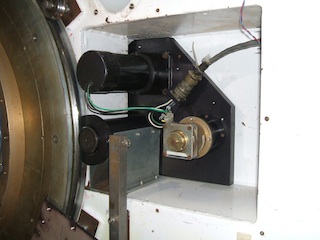
Guide to the new MDM Hiltner Rotator
The rotator motor and associated electronics were upgraded in April and May 2011. The original rotator motor was replaced with a Parker model LV342-01-10 Stepper motor and model PX34-010-L2 10:1 Planetary Gearbox, which has the required precision (0.01 degrees) to align OSMOS slit masks. The motor is controlled with a MicroLYNX-7 programmable stepper motor driver, which may be operated via a GUI in the control room or via a handpaddle from the dome.
Tom O'Brien and Dan Pappalardo installed the new electronics box, limit switches, and handpaddle in April 2011. In May 2011 Tom, Paul Martini, Rebecca Stoll, and Joe Antognini installed and tested the new motor with the new handpaddle and the new Rotator GUI by Ray Gonzalez. This GUI was used to align the first multi-slit mask and obtain the first multi-object spectra with OSMOS.
Below are some photos of the rotator installation and MOS commissioning from May 2011. Click on an image to see a larger version.
The old motor installed in the telescope cell immediately prior to removal.
The old belt and motor assembly on a lab bench.
Tom installing the new motor and gearbox. A new drive belt was also installed.
The new motor installed on the telescope. The contact for the rotator limit switches is in the foreground.
The rotator electronics box and hand paddle.
The counter-clockwise limit switch.
Patch panel with inputs from the limit switches, etc.
A screenshot of the new Rotator GUI, which is used to send small offsets from the control room.
Multi-slit mask installed in a cell. The mask blanks are an electroformed, spherical shell that matches the curvature of the telescope focal surface. The slits are approximately 90 microns (1 arcsec) wide and cut with a laser. The boxes for alignment stars are 5 times larger.
The first multi-slit spectrum obtained with OSMOS! This mask includes a number of eclipsing binaries in the Cygus OB association. The three bright features across the center of the image are the dispersed light from apertures for alignment stars.